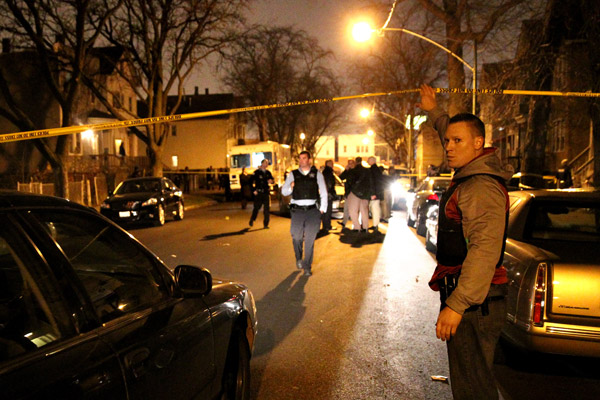
Chris Sweda/Chicago Tribune
Chicago police at the scene of a shooting in Fuller Park, November 30, 2012.
The other day Edward McClelland, writing for NBC Chicago's Ward Room, put together a list of Chicago's most "depopulated" communities—those with the most substantial population decline from 1950 (the city's peak) to 2010. Over those 60 years, the city lost 925,364 people, falling about a quarter from 3,620,962 to 2,695,598.
But not all of the city's community areas declined in population, and precipitous decline (over 50%) was concentrated in a couple specific areas. In order to see the geography of the city's population change, I mapped McClelland's data.
The community with the largest percentage decline was Fuller Park (it's a small community area, declining from about 17,000 to less than 3,000, so it doesn't represent a big raw decline). As McClelland describes, it was overcrowded because of restrictive covenants; when those were banned, the population collapsed.
What's left is arguably the city's most troubled neighborhood. Its "hardship score" is the city's highest:
It has the second-highest percentage of households below the poverty line (55.5 percent), the highest unemployment rate (40 percent), and the second-lowest per-capita income ($9,016, one of only two Chicago community areas with a per-capita income below $10,000).
As of late last year, it was the only community area with a food-insecure population over 50 percent. And it's surrounded by other troubled neighborhoods; Washington Park lost 79 percent of its population (from 57,000 to 12,000), and last time I checked, it had the highest homicide rate in Chicago.
But it has not been all bad news. Outside of the Loop, the most substantial gains in the city's population are all on the southwest side: 450 percent in Ashburn, 168 percent in Garfield Ridge, 131 percent in neighborhing West Lawn, 134 percent in West Elsdon, 118 percent in Clearing. All the community areas outside the loop that doubled (or more) in population are concentrated in that southwest corner of Chicago, which outpaced the growth on the northwest side, where populations grew from 20-50 percent.



